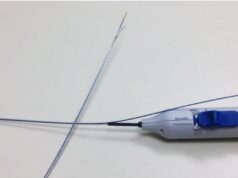 An evaluation of the Vascular Quality Initiative’s (VQI) Varicose Vein Registry (VVR) carried out by the Midwestern Vascular Surgical Society (MVSS) has found women to benefit similarly from endovenous ablation as men, but experience fewer complications post-procedure.
An evaluation of the Vascular Quality Initiative’s (VQI) Varicose Vein Registry (VVR) carried out by the Midwestern Vascular Surgical Society (MVSS) has found women to benefit similarly from endovenous ablation as men, but experience fewer complications post-procedure.
The MVSS study prospectively collected data from the VVR—a registry included within the VQI which tracks venous procedures. Uniquely, the VVR includes both patient-and physician-reported outcomes. Using these data, Benjamin A Y Cher (University of Michigan, Michigan, USA) and colleagues conducted a retrospective cohort evaluation of patients undergoing endovenous ablation procedures on truncal veins with or without treatment of perforated veins between 2015 and 2019. Inclusion criteria consisted of patients who underwent procedures to ablate truncal veins using radiofrequency or laser in the lower extremity within the specified period. The investigators assigned two follow-up points—early at zero-to-three months post-procedure and greater than three months—to record symptom severity scores.
The investigators conducted a univariate analysis to compare preprocedural, post-procedural and periprocedural changes in Clinical, Etiologic, Anatomic, and Physiologic (CEAP) classification and Venous Clinical Severity Score (VCSS) by gender and measured rates of complications including: deep venous thrombosis, endovenous head-induced thrombosis, leg pigmentation, blistering, paraesthesia, incisional infection and any others reported post-procedure. For each of the included cases initial demographic reporting consisted of age, gender, race and clinical history, such as prior varicose vein treatment, compliance with compression therapy, presence of deep reflux and other prescribed therapies such as anticoagulation, concomitant with phlebectomy and concomitant with sclerotherapy treatments.
Key results
Cher et al write that the cases included within the study amounted to 9,743 patients, 3,090 (31.7%) of which were men and 6,653 (68.2%) were women. By gender, averages for age, percent non-white race and body mass index (BMI) were largely similar.
When analysing preoperative characteristics, compared with men, women had a higher preoperative symptom score (average 15.0 for women vs. 14.1 for men, p<0.001), despite presenting for treatment with lower overall CEAP classification (p<0.001) and VCSS classes (average 7.54 women vs. 8.84 men, p<0.001). Women also more frequently underwent prior varicose vein treatment (25.2% vs. 19.6%, p<0.001), whereas men were more likely to have a prior history of anticoagulation (13.0% vs. 6.5%, p<0.001).
In regression analyses, the authors found gendered disparities across perioperative changes in VCSS scores were as driven by additional characteristics such as BMI, presence of deep reflux and preoperative CEAP classification. In patients with a BMI greater than 40, women had a higher periprocedural improvement in VCSS score of 0.69 points (95% confidence interval [CI], 0.32–1.05). In patients with deep reflux, periprocedural VCSS scores were higher among women by 0.25 points (95% CI, 0.07–0.44). Additionally, among patients with a preoperative CEAP classification of 2 (739 men, 25.1%, 2,248 women, 35.1%), women reported a greater periprocedural decrease in VCSS score by 0.32 points (95% CI, 0.07–0.57).
Between both groups, incidence of post-procedural complications was low, with women showing a lower frequency overall. Cher and colleagues’ results show that in each of the measured areas of post-procedural complications, women benefitted more than men in terms of pain-incidence, including any leg complication (6.1% vs. 8.6%, p=0.001), endovenous heat-induced thrombosis (1.1% vs. 2.2%, p=0.002), and infection (0.4% vs. 0.7%, p=0.001).
Data collected from post-procedure outcomes revealed that women had a lower postoperative total VCSS score (3.50) compared with men (4.47), which marks a greater improvement in score for women than men (average -4.46 for men vs -4.13 for women, p<0.0001).
Drawing conclusions
The study authors conclude that women present for endovenous ablation with a lower VCSS score and lower CEAP classification than men, yet report a higher total symptom score, suggesting quantifiable differences in experience of venous disease between groups. The investigators remark that their results may complicate the accuracy of prevalent comparisons of venous disease by gender, positing variations in reasons for presenting for treatment and physiological differences between gender groups.
The authors note that men and women seek treatment for endovenous ablation for differing reasons, however considering the positive results found among women, endovenous ablation may be best suited to treating the common presentation characteristics women report (pain, achiness, and heaviness) rather than those reported among men (oedema, inflammation, and itching). This hypothesis is supported by the finding that women presented for treatment with lower overall CEAP classification.
Physiologically, Cher et al point to the role of oestrogen, noting the preprocedural change in VCSS score being greater among women with a higher BMI than men with a higher BMI—obesity and increased oestrogen production being concurrent. The investigators note that gendered differences between oestrogen physiology by BMI may also explain observed interactions between gender and deep reflux being more common among obese patients. However, the authors make clear some important limitations of the VVR registry, which does not contain data relating to the presence of tributaries, the location of deep reflux or data on postoperative ultrasounds, and additionally note the observational nature of the study itself as there remains the possibility of residual confounding by variables not captured in the VVR.
Cher and colleagues summarise that their findings demonstrate a similar benefit from endovenous ablation between women and men, with little incidence of post-procedural complications for both. However, considering the study’s procedural registry included almost twice as many women as men, findings which suggest a greater benefit from treatment for women are particularly significant. Commenting on the broader application of their results, the authors note, “our results suggest gender may be useful for patient selection and counselling for endovenous ablation, with particular usefulness among patients with high BMI, presence of deep reflux, and preoperative CEAP classification of 2.”












